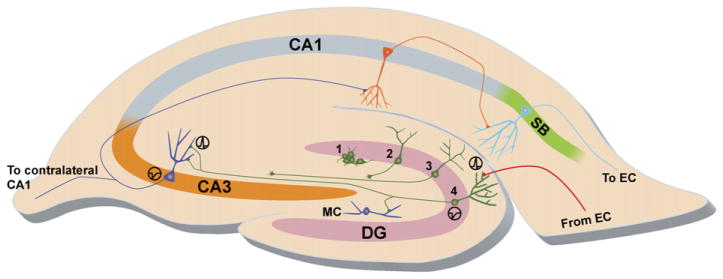Fig. 1.
DG neurogenesis incorporation of new neurons. Neurogenesis in the hippocampus occurs in the SGZ of the DG, wherein neural progenitor cells reside (1). Within the first week after birth, these progenitors undergo a fate choice, in this case, becoming an immature neuron (2) with developing neurites. The axons of these new granule neurons are guided through the hilus of the DG, with long-distance branches targeting the CA3 (3) and the dendrites extending into the molecular layer (3). After 3 to 4 weeks, these cells form a mature phenotype, with their dendrites containing spines that receive input primarily from the entorhinal cortex (EC) by way of the perforant pathway (red axon) and their highly branched axons that output to CA3 pyramidal neurons (4) and hilar mossy cells (MC) by way of the mossy fiber pathway (green axon). Continuing the hippocampal circuitry, the CA3 pyramidal neurons output to the CA1 ipsilateral pyramidal neurons by way of the Schaffer collateral pathway or contralaterally by way of the associational commissural pathway (blue axon). The CA1 pyramidal neurons output (orange axon) to pyramidal neurons of the subiculum (SB), which output (cyan axon) to the EC, and these neurons eventually output to the parahippocampal and perirhinal cortex. Ultimately, the circuitry connects to the association cortices.

